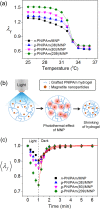Photothermally driven fast responding photo-actuators fabricated with comb-type hydrogels and magnetite nanoparticles
- PMID: 26459918
- PMCID: PMC4602301
- DOI: 10.1038/srep15124
Photothermally driven fast responding photo-actuators fabricated with comb-type hydrogels and magnetite nanoparticles
Abstract
To overcome the slow kinetics of the volume phase transition of stimuli-responsive hydrogels as platforms for soft actuators, thermally responsive comb-type hydrogels were prepared using synthesized poly(N-isopropylacrylamide) macromonomers bearing graft chains. Fast responding light-responsive hydrogels were fabricated by combining a comb-type hydrogel matrix with photothermal magnetite nanoparticles (MNP). The MNPs dispersed in the matrix provide heat to stimulate the volume change of the hydrogel matrix by converting absorbed visible light to thermal energy. In this process, the comb-type hydrogel matrix exhibited a rapid response due to the free, mobile grafted chains. The comb-type hydrogel exhibited significantly enhanced light-induced volume shrinkage and rapid recovery. The comb-type hydrogels containing MNP were successfully used to fabricate a bilayer-type photo-actuator with fast bending motion.
Figures




References
-
- Ahn S.-K., Kasi R. M., Kim S.-C., Sharma N. & Zhou Y. Stimuli-responsive polymer gels. Soft Matter 4, 1151–1157 (2008). - PubMed
-
- Mano J. F. Stimuli‐responsive polymeric systems for biomedical applications. Adv. Eng. Mater. 10, 515–527 (2008).
-
- Zhang J.-T., Keller T. F., Bhat R., Garipcan B. & Jandt K. D. A novel two-level microstructured poly (N-isopropylacrylamide) hydrogel for controlled release. Acta Biomater. 6, 3890–3898 (2010). - PubMed
-
- Trongsatitkul T. & Budhlall B. M. Microgels or microcapsules? Role of morphology on the release kinetics of thermoresponsive PNIPAm-co-PEGMa hydrogels. Polym. Chem . 4, 1502–1516 (2013).
-
- Satarkar N. S., Zhang W., Eitel R. E. & Hilt J. Z. Magnetic hydrogel nanocomposites as remote controlled microfluidic valves. Lab Chip 9, 1773–1779 (2009). - PubMed
LinkOut - more resources
Full Text Sources
Other Literature Sources

